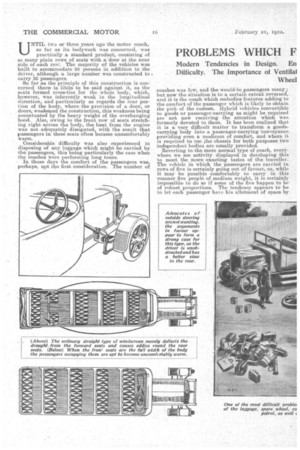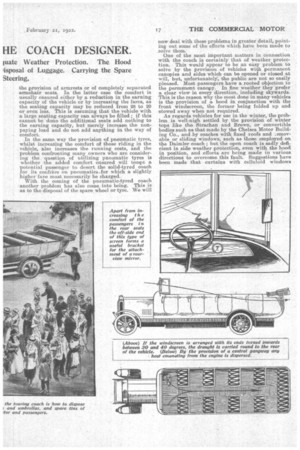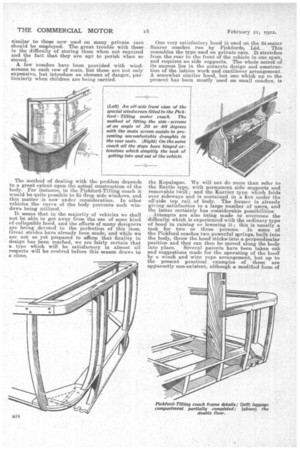PROBLEMS WHICH F HE COACH DESIGNER.
Page 16

Page 17

Page 18

Page 19

If you've noticed an error in this article please click here to report it so we can fix it.
Modern Tendencies in Design. En Difficulty. The Importance of Ventilat Wheel pate Weather Protection. The Hood lisposal of Luggage. Carrying the Spare Steering.
UNTIL two or three years ago the motor coach, so far as its bodywork was concerned, was practically a, standard product, consisting of so many plain rows of seats with a-door at the near side of each row. The majority of the vehicles was built to accommodate 28 persons in addition to the driver, although a, large number was constructed to carry 33 passengers. So far as the principle a this construction is concerned there is little to be said against it, as the seats formed, cross-tics for the whole body, which, however, was inherently weak in the longitudinal. direction, and particularly as regards the rear portion of the body, where the provision of a door, or doors, weakened the construction, this weakness being accentuated by the heavy weight of the overhanging hood. Also, owing to the front row of seats stretching right across the body, the heat from the engine was not •adequately dissipated, with the result that passengers in these seats often became uncomfortably warm.
• Considerable difficulty was also experienced in 'disposing of any luggage which might be carried by the passengers, this being particularly the case when the coaches were performing long tours. In. those days the comfort of the passengers was, perhaps, not the first consideration. The number of
coaches was few, and the would-he passengers many; but now the situation is to a certain extent reversed, and ibis the coach which embodies features adding to the comfort of the passenger which is likely to obtain the pick of the custom.. Hybrid vehicles convertible to goods or passenger-carrying as might be required are not now receiving the attention which was formerly devoted to them. It has been realized that it is a very difficult matter to transform a goodscarrying body into, a passenger-carrying -conveyance providing even a modicum of comfort, and where it is required to usc ihe chassis for both purposes two independent bodies are usually provided.
Reverting to the more normal type of coach, everywhere we see activity displayed in developing this to meet the more exacting tastes of the traveller.. The vehicle in which the passengers are carried in rows of five is certainly .going out of favour, as, while it may be possible comfortably to carry in this manner five people of medium weight, it is certainly impossible to do so if some of the five happen to be of robust proportions. The tendency appears to be to let each passenger have his allotment of space by the provision of armrests or of completely separated armchair seats. In the latter case the comfort is usually ensured either by a reduction in the earning capacity of the vehicle or by increasing the fares, as the seating capacity may be reduced from 28 to 20 or even less. This is assuming that the vehicle with a large seating capacity can always be filled ; if this cannot be done the additional seats add nothing to the earning capacity, but merely increase, the nonpaying load and do not add anything in the way of comfort.
In the same way the provision of pneumatic tyres, whilst increasing the comfort of those riding in the vehicle, also increases the running costs, and the problem confronting many owners who are considering the question of utilizing pneumatic tyres is whether the added comfort ensured will tempt a potential passenger to desert the solid-tyred coach for its confrere on pneumatics.for which a slightly higher fare must necessarily be charged.
With the coming of the pneumatic-tyred coach another problem has also come into being. This is as to the disposal of the spare. wheel or tyre. We will
now deal with these problems in greater detail, pointing out some of the efforts which have been made to solve them.
One of the most important matters in connection with the coach, is certainly that of weather protection. This would appear to be an easy problem to solve by the provision of vehicles with permanent canopies and sides which can be opened or closed at will, but, unfortunately; the public are not so easily pleased. Most passengers have a rooted objection to the permanent canopy. In fine weather they 'prefer a clear view in every direction, including sk-ywards. This is the reason why the most done in many vehicles is the provision of a hood in conjunction with the front windscreen, the former being folded up and stowed away when not required. As regards vehicles for use in the winter, the prOblem is well-nigh settled by the provision of winter tops like the Strachan and Brown, or convertible bodies such as that made by the Chelsea Motor Building Co., and by coaches with fixed roofs and .emovable or sliding windows' such as those employed on the Daimler coach • but the open coach is sadly deficient in side weather protection, even with the hood in position and efforts axe being made in various directions .1,,o overcome this fault. Suggestions have been made that curtains with celluloid windows
similar to those now used on many private cars should be employed. The great trouble with these is the difficulty of storing them when not required and the fact that they are apt to perish when so stored.
A few coaches have been provided with windscreens to each row of seats, but these are not only expensive, but introduce an element of danger, particularly when children are being carried.
The method of dealing with the problem depends to a great exlent upon the actual construction of the body. For instance, in the Pickford-Tilling coach it would be quite possible to fit drop side windows, and this matter is now under consideration. In other vehicles the curve of the body prevents such windows being utilizod: •
It seems that in the majority of vehicles we shall not be able to get away from the use of some kind of collapsible hood, and the efforts of many designers are being devoted to the perfection of this item. Great strides have already been made, and while we are not as yet prepared to affirm that finality in design has been reached, we are fairly certain that a type which will be satisfactory in almost all respects will be evolved before this season draws to a close.
One very satisfactory hood is used on the 24-seater Saurer coaches run by Pickfords, Ltd. This resembles the type used on private cars. It stretches from the rear to the front of the vehicle in one span, and requires no side supports. The whole secret of its success lies in the accurate design and construction of the lattice work and cantilever arrangement. A somewhat similar hood, but one which up to the present has been mostly used an small coaches, is the Kopalapso, We will not do more than Ikefer to the Bartle type, with permanent side supports and removable twill,; and the Karrier type,. which folds over sideways and is contained in a tax under the off-side top rail, of body. The former is already giving satisfaction to a large number of users, and the latter eertainly has considerable possibilities. .. Attempts are also being made to overcome the difficulty which is experienced with the ordinary type of hood in raising or lowering it ; this is usually a task for two or three persons. In some of the Piekford coaches two powerful springs, built into the body, throw the hood stieksinto a perpendicular position and they can then be moved along the body into place. Several patents have been taken out and suggestions made for the operating of the hood by a winch and wire rope arrangement, but up to the present practical examples of these are apparently non-existent, although a modified form of this construction is to have longitudinal fixed wires or tubular supports, the hoop sticks and material being drawn over them and fastened to the windscreen. Of these types good examples are the Mumford and the Leyland. We have already alluded to the uncomfortable warmth experienced by the passengers in the front seats when these stretch right across the body. This trouble is practically overcome in the type of body which includes a central gangway, as the warm air is then dispersed.
With separate seats, or those divided by a gangway, the body has to be built of greater strength than normally, as it is not cross-tied by seats and in the Pickford-Tilling coach great strength is obtained by the use of a double floor, the upper floor rising to the rear so that the wheel arches do not protrude unduly into the body. One of the greatest problems which face the owner i of the touring coach s that of the disposal of any luggage carried by the passengers. Each person must carry at least a medium-sized suit case, and in many coaches practicallyno provision is made for these articles, although in the Bartle body sufficient space is allowed under each seat for a suit case, whilst in other vehicles designed especially for touring, a luggage compartment is sometimes provided at the rear. Luggage containers along the running boards are not always satisfactory, as they render important parts of the chassis inaccessible, and the question still requires unremitting attention. In those vehicles. fitted with pneumatic tyres, another problem of storage comes into being. That is the positioning of the spare tyre in the case of giant pneumatics or spare wheel when the ordinary type is employed, and in some coaches the luggage locker is dispensed with and a wheel locker substituted, which is merely robbing Peter to pay Paul.
In the de luxe type of coach provision should also he made for the storing of rugs, loose coats, etc., and rugs may be carried on rails behind the seats.
For long-distance travelling it is necessary to provide suitable footrests, as, after a time, if the feet are placed on a flat 'surface, the insteps become strained. Certain designers advocate the fitting of outside steering, so that the driver can sit at the extreme right of the vehicle and suffer no inconvenience from having a conductor or passenger at his right side, whilst at the same time he can obtain a good view to the rear ; this, incidentally, should be assisted by the provision of a rear-view mirror, which van be fitted direct to the turned-in end of the windscreen, when this type of screen is provided. In some parts of the country, outside steering would permit of the carrying of an extra passenger at the front, but as regards London the Public Carriage Department will not permit more than next to the driver. two passengers to be carried The sketches of constructional details which we reproduce show various points of interest in the building of the Pickford-Tilling coach body, but we would point out that the design of the complete body is registered. For the opportunity of obtaining these sketches, and also for a considerable amount of the information contained in this article, we desire to tender our thanks to Thomas Tilling, Ltd., and to Mr. E. Hodges, the managing coachbuilder to the company.






























